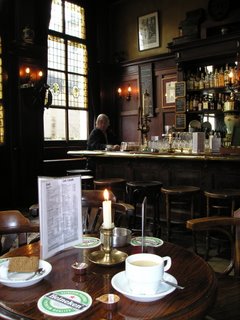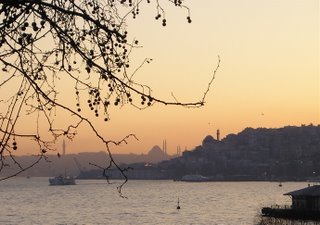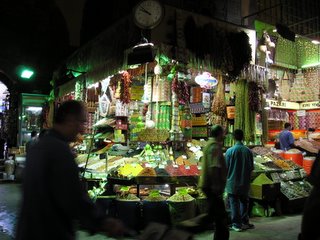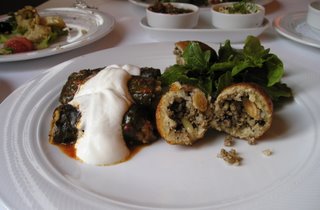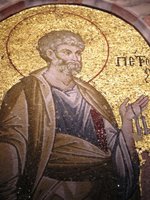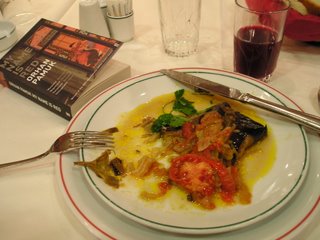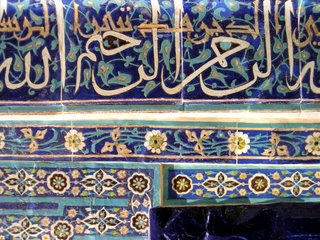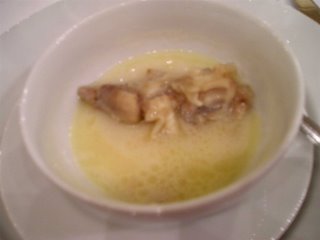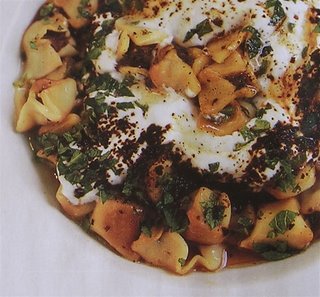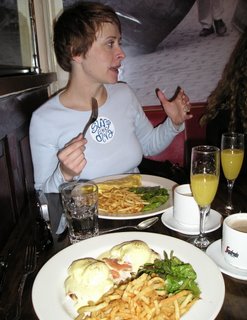 Saturday began slowly. Our hotel was having major problems with its lifts - guests kept getting stuck inside them - so it was operating only the grimy service lift for most of our stay. Needless to say it took a while to get downstairs with only one lift working. But things picked up with brunch in Soho, and this time with current and former New Yorkers as guides we saw Soho at its best. We brunched on mimosas and eggs benedict at French café Manon on W Houston - in the former space of Deux Gamins (set up by Robert Arbor, whose recent book tried to instil some French joie de vivre into Americans' lives. (Incidentally, most haute cuisine in NYC is French - unlike in Australia, where we are under Italy's thrall).
Saturday began slowly. Our hotel was having major problems with its lifts - guests kept getting stuck inside them - so it was operating only the grimy service lift for most of our stay. Needless to say it took a while to get downstairs with only one lift working. But things picked up with brunch in Soho, and this time with current and former New Yorkers as guides we saw Soho at its best. We brunched on mimosas and eggs benedict at French café Manon on W Houston - in the former space of Deux Gamins (set up by Robert Arbor, whose recent book tried to instil some French joie de vivre into Americans' lives. (Incidentally, most haute cuisine in NYC is French - unlike in Australia, where we are under Italy's thrall). 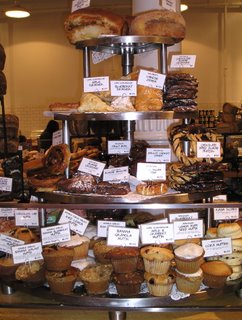 Then we prowled the cobble-stoned streets beneath fire escapes hanging off the cast-iron buildings and prowl the boutiques, including Barneys Co-op (for a wine velvet Marc Jacobs shrug) and the luxe Dean & DeLuca gastro-emporium (bakery counter pictured left). Pricey, but worth a browse. So much sumptuous and fresh food on display, I was salivating.
Then we prowled the cobble-stoned streets beneath fire escapes hanging off the cast-iron buildings and prowl the boutiques, including Barneys Co-op (for a wine velvet Marc Jacobs shrug) and the luxe Dean & DeLuca gastro-emporium (bakery counter pictured left). Pricey, but worth a browse. So much sumptuous and fresh food on display, I was salivating.Late in the afternoon Fara and I caught the subway to the Upper West Side to visit her friend Rona in her fantastic apartment which was once the parlour of an elegant brownstone. I could easily see myself living there, curled up with the New Yorker in front of the floor-to-ceiling windows, with Central Park just a few steps away. Took at ramble around the Park where the trees are budding and the daffodils had just burst into flower, before meeting Gerard back at the hotel. Dinner with Fara and her friends at Bello Sguardo back in the swanky Upper West Side on Amsterdam Avenue, for elegant Mediterranean fare with a neighbourly feel. Where, amazingly, it transpired that Fara's Dubliner pal Rona was Gerard's best mate's cousin. The media world is indeed a small one. The evening ended with a late-night subway ride with a cupcake at the end - a red velvet one with satin buttercream frosting and little heart-shaped sprinkles from the Sugar Sweet Sunshine Bakery in the Lower East Side. Red velvet cake? Popular in the American south, it's got cocoa in it, and red food colouring. Yeah, I know. Food colouring. Somehow the colour enhances the taste though. Cupcakes are definitely having a fashion moment; blame the Magnolia Bakery and that Sex and the City episode.
On Sunday morning we slurped dimsum in Chinatown beneath the Brooklyn Bridge, then we walked around bustling backstreets in search of Fara's favourite handbag stall where I picked up a very good "Birkin-inspired" ostrich leather bag. Then Lisa and I paid our respects at Bloomingdale's (in Ann Arbor we are truly shopping deprived!) before I went uptown for two swooning hours at the Frick Museum. Words cannot do this place justice. It's a small but perfectly formed feast of masterpieces - from the canvases to the sculpture, period furniture, even entire rooms shipped out from French palaces. There's a sublime Vermeer, an ecstatic Bellini, and two Holbeins of Thomas More and Thomas Cromwell facing off each other from either side of a fireplace. I wonder how long Henry Clay Frick dreamt of owning them both so that they could stare each other down for all eternity.
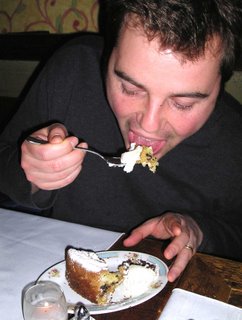 The Frick could have been sufficient food for me that night, but we had more treats in store. The appetiser was the view of the lower Manhattan skyline from the Manhattan Bridge en route to Brooklyn, where we met up with Graham and his friends Leslie and Jim for a sublime dinner at Al di Là Trattoria. This place is a real find; I am so thankful that Manhattanite snobs are reluctant to enter Brooklyn, because then this place might charge a lot more for its gutsy, honest Italian food. Some stars from the menu? The white asparagus with poached egg and parmesan; the baccala mantecaqto with grilled polenta, the casunziei (homemade ravioli filled with red beets and ricotta, served with melted butter and poppy seeds); hand-cut tagliatelle with a meat ragu; and braised rabbit with black olives and creamy polenta. A pear and chocolate cake and an affogato lent a sweet finish, and their wine list (and downstairs wine bar) added more magic. This was the meal of the trip.
The Frick could have been sufficient food for me that night, but we had more treats in store. The appetiser was the view of the lower Manhattan skyline from the Manhattan Bridge en route to Brooklyn, where we met up with Graham and his friends Leslie and Jim for a sublime dinner at Al di Là Trattoria. This place is a real find; I am so thankful that Manhattanite snobs are reluctant to enter Brooklyn, because then this place might charge a lot more for its gutsy, honest Italian food. Some stars from the menu? The white asparagus with poached egg and parmesan; the baccala mantecaqto with grilled polenta, the casunziei (homemade ravioli filled with red beets and ricotta, served with melted butter and poppy seeds); hand-cut tagliatelle with a meat ragu; and braised rabbit with black olives and creamy polenta. A pear and chocolate cake and an affogato lent a sweet finish, and their wine list (and downstairs wine bar) added more magic. This was the meal of the trip.Monday was a working day: after onion bagels from the corner deli we visited the Wall Street Journal (their building recognisable from photos of September 11 - being adjacent to Ground Zero it was used as a temporary morgue) and spent several hours at the New York Times, including lunch with the managing editor.
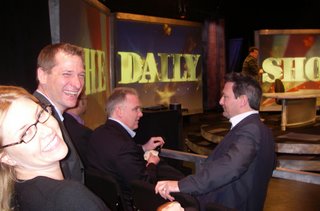
In the early evening Graham's friend Jim got us prime seats at the taping of The Daily Show, where we hammered for being the only people in the audience dressed in business attire. Jon Stewart is still cute in person, but actually better looking on the TV screen. The night swung on when a splinter group took drinks at the British consul’s apartment (after an exhilarating cab ride through some of NYC's more glittering streets) before we met up with the rest of the gang at Artisanal for a dinner of cheese gougères, fondue and still more cheese with rather a bit of Argentinian malbec, one of the iconic drinks of the fellowship.
My final (futile?) act in New York was purchasing the City Secrets guidebook at the Met's airport store. Only 5 days too late. It's a compendium of beautifully-written prose worthy of the great city, and is great fodder for armchair travelling and as an aide-memoire. Hopefully I'll get to make use of it in NYC soon.

